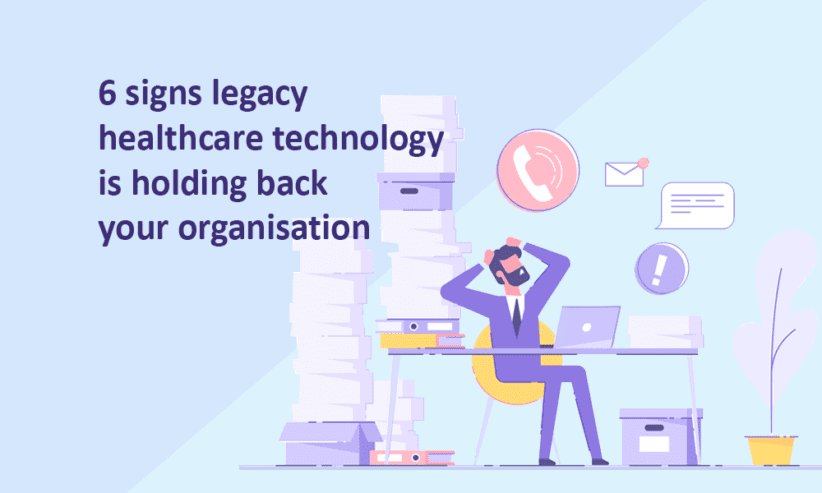Legacy healthcare technology survives on the lifeline of the adage: if it’s not broken, don’t fix it. After all, people don’t like change. Regardless of whether you have gone through medical school or are still climbing the ladder, change is difficult.
Therefore, healthcare professionals continue to keep legacy healthcare technology on life support, refusing to change because it is familiar.
Unfortunately, continuing the ill-fated process of maintaining the high maintenance costs, dealing with the outdated software causing data fragmentation and access problems is only causing your staff despair and posing a significant risk to patient safety.
As technology advances, leaving legacy healthcare ineptitudes further behind, the bigger the problem becomes.
Even worse is that without knowing the signs of decline, your organisation may not even know how far legacy healthcare technology is holding you back.
So, here are six signs that your legacy healthcare technology is affecting your organisation’s staff and, ultimately, endangering your patients:
Sign 1: Clinician Burnout
Burnout is an increasing issue facing overwhelmed, overworked and understaffed clinicians. The rising rate of burnout throughout the healthcare field proves to have dire consequences for the patients and organisations these professionals represent. The healthcare profession is challenging enough without the added disconnect between technological innovation and patient care.
When the tools your team needs to do their jobs efficiently cannot keep up with the ever-evolving landscape of technological and clinical advancements, burnout is imminent and rapid.
After all, the world is changing around them, bringing new-age issues that medical professionals need to solve with rudimentary tools.
Sign 2: Core Hospital Operational Processes are FAX and Paper-Based
Commonly, people like to have tangible information. Important documents, such as test results and prescriptions, are examples of information that many medical professionals and their patients want to hold in their hands physically.
Despite the abundance of digital information people interact with daily, certain documents have a stigma of being less official if they are digital. Many of these stigmatised documents are health-related material.
However, information sharing and protection on the digital plane has evolved beyond this stigma. Physical data that needs to be faxed or mailed instead of shared via an encrypted system is much more vulnerable to manipulation and mistake.
FAXes and other paper-based reports are subject to being destroyed or obtained by people who should not have that information.
Alternatively, digital records get protected by login credentials and firewalls that prevent destruction, corruption, or prying eyes in a way that fax or paper-based data sharing could never achieve.
Sign 3: Upgrades are Costly and Time-Consuming
Legacy healthcare technology is facility-based, on-location documentation, either physical or digital, which is inherently slow and cumbersome. If you are working with physical files, any updates are costly and time-consuming. Yet, even if you have some antiquated digital system, everything about it runs ineffectively. While some digital systems can be better than nothing, chances are using the system, much less updating it, is a large, hassle-filled project.
Often, if something breaks or there is an issue, finding someone specialising in such an outdated system can be challenging and expensive.
Sign 4: Wading Through Fragmented Episodic Data
Johns Hopkins University published a study that suggests medical errors are the third leading cause of death. However, most of these errors aren’t due to human error or the wrong data being input into the patient’s file. Instead, the cause is the continual use of legacy healthcare technology, with systems that bury patient information inside folders and applications, without a single patient view.
Legacy healthcare technology cannot collaborate with different applications like modern technology can. So, instead of having all the data for one patient organised into one digital file, the patient’s complete health profile is buried in pieces across multiple applications.
Sign 5: Accuracy of Hospital Reported Data
The hospital clerical staff is generally responsible for gathering data from patients and pulling reports. However, clerical errors, coding errors, and severe oversights due to inconsistent, missing, or errored data are significant problems that affect patients’ safety.
Dr. Russ Richmond, MD, CEO of Objective Health, suggests that it isn’t so much that the staff isn’t doing their jobs. Instead, the wealth of information they are asked to collect is useless to the patient’s wellbeing. While the billing department and statistical analysis might do wonders with data collected, the same data could leave the individual’s clinician at a loss. Since the collected data is fragmented and disjointed, it is nearly impossible to see the whole picture.
Sign 6: Current Tools Do Not Support Patient Engagement
Technological advancements are everywhere. The more advanced technology becomes, the more engagement patients expect to have over their health and wellness. Plus, the more patients are involved in their health by having access to their test results and wellbeing specifics, the less chance an error will go unnoticed.
Unfortunately, most of the current tools do not support patient engagement. Most of the tools are confusing, hard to decipher, insecure for sharing, and often unable to be shared at all.
Clinicians cannot instinctively know how their patients feel, and they cannot follow them around. Healthcare professionals only have access to the information available from their tests and what their patient knows to tell them.
However, suppose your patient has the proper tools to view and understand the information healthcare professionals have. In that case, it will give them a better understanding of what they need to watch within themselves. This information will enable patients to express their concerns easier and more accurately, helping clinicians treat their patients’ ailments with more success.
Now is the time to tear down legacy applications hurting the mission of your organisation. Stop the threat to your patients’ safety and your staff’s sanity by embracing a data-driven digital path to empower your care delivery team.
Download the free DC2Vue’s Insider’s guide to Data-Driven Healthcare Digital White Paper today and prepare to enter a new world of healthcare technology innovation.



